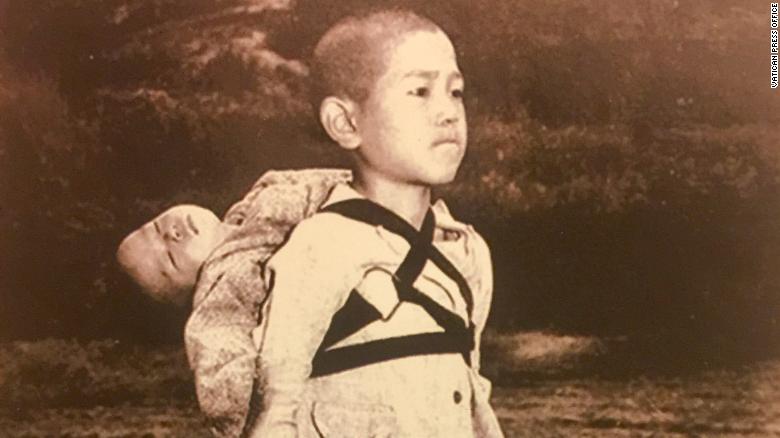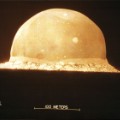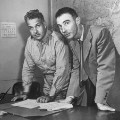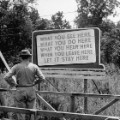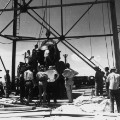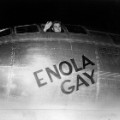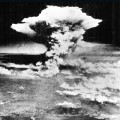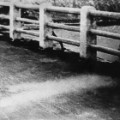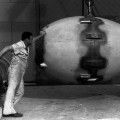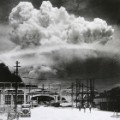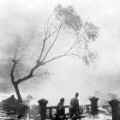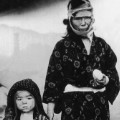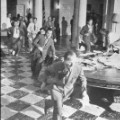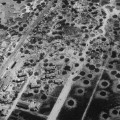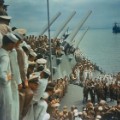The first use of the atomic bomb
The United States detonates the world's first atomic bomb at a test site in New Mexico on July 16, 1945. Less than a month later, atomic bombs were dropped on the Japanese cities of Hiroshima and Nagasaki. The devastation led to Japan's unconditional surrender and brought an end to World War II.
The first use of the atomic bomb
In 1939, physicists Albert Einstein, left, and Leo Szilard drafted a letter to U.S. President Franklin D. Roosevelt, urging him to research atomic bombs before the Germans could build one first. By 1942, the United States had approved the top-secret Manhattan Project to build a nuclear reactor and assemble an atomic bomb.
The first use of the atomic bomb
In 1942, U.S. Army Col. Leslie R. Groves, left, was appointed to head the Manhattan Project. On the right is physicist J. Robert Oppenheimer, who led the Los Alamos National Laboratory in New Mexico.
The first use of the atomic bomb
Los Alamos workers pose on a platform stacked with 100 tons of TNT. It was to be used to gauge radioactive fallout.
The first use of the atomic bomb
The Manhattan Project also involved research facilities in Oak Ridge, Tennessee, and Hanford, Washington. Billboards, like this one in Oak Ridge, reminded workers of the project's top-secret nature.
The first use of the atomic bomb
Workers in New Mexico attach a bomb to a tower two days before its successful test in July 1945.
The first use of the atomic bomb
Trinity was the code name of the test bomb, which was detonated in the Jornada del Muerto desert.
The first use of the atomic bomb
Air Force Col. Paul Tibbetts waves from the pilot's seat of the Enola Gay moments before takeoff on August 6, 1945. A short time later, the plane's crew dropped the first atomic bomb in combat, instantly killing 80,000 people in Hiroshima.
The first use of the atomic bomb
An aerial photograph of Hiroshima shortly after the atomic bomb, nicknamed "Little Boy," was dropped.
The first use of the atomic bomb
U.S. President Harry Truman, aboard a U.S. Navy cruiser, reads reports of the Hiroshima bombing. Eight days earlier, Truman had warned Japan that the country would be destroyed if it did not surrender unconditionally.
The first use of the atomic bomb
A white silhouette on a Hiroshima bridge shows an area that wasn't scorched by the bomb. It was reportedly the outline of a person's shadow -- someone who was shielded from the blast's heat rays by another person.
The first use of the atomic bomb
An elderly victim is covered with flies in a makeshift hospital in Hiroshima.
The first use of the atomic bomb
A worker stands next to an atomic bomb, nicknamed "Fat Man," hours before it was dropped on Nagasaki, Japan, on August 9, 1945.
The first use of the atomic bomb
This photo was taken about six miles from the scene of the Nagasaki explosion. According to the Nagasaki Atomic Bomb Museum, photographer Hiromichi Matsuda took this photograph 15 minutes after the attack.
The first use of the atomic bomb
Survivors of the Nagasaki bomb walk through the destruction as fire rages in the background.
The first use of the atomic bomb
A woman and a child walk in Nagasaki on the day of the bombing. More than 70,000 people there were killed instantly.
The first use of the atomic bomb
Members of the White House Press Corps rush to telephones after Truman announced Japan's surrender on August 15, 1945.
The first use of the atomic bomb
An aerial view of Hiroshima three weeks after the atomic bomb.
The first use of the atomic bomb
Soldiers and sailors on the USS Missouri watch as Japan's formal surrender is signed in Tokyo Bay on September 2, 1945.

